Automated and Cashierless Checkout: The Cornerstone of Autonomous Stores

The retail automation market was worth $12.2 billion in 2021, and is forecast to nearly triple in value to $33 billion by 2030.
What’s the goal of all this investment in automation? Apart from innovation and streamlining, a big part of it is providing a better customer experience. For 80% of American consumers, speed and convenience are the key elements of a good experience.
Combining artificial intelligence (AI), computer vision (ML), and internet of things (IoT) sensors, we can get the ultimate customer experience – an intelligent, autonomous store. Customers can walk in, pick their products, and just walk out. The whole buying process happens in the background.
Definition of intelligent, autonomous stores
An autonomous store integrates overhead surveillance systems with intelligent shelving units for real-time monitoring.
Then, when a customer takes a product, their electronic shopping cart is dynamically updated, streamlining the checkout process.
With a payment system integration, the customer doesn’t have to stop to pay for their products, it happens automatically when they leave the store.
In the background, there’s a complex backend system that orchestrates all of the different necessary integrations into one, cohesive shopping experience.
One of the biggest challenges in autonomous store development is the data layer. It is the middleman between all of the different sensors and the backend system that powers the store’s functionalities.
Autonomous stores rely on real-time data streams from IoT devices like sensors and cameras, and the data layer stands as the heart of monitoring and observability, ensuring that the vast amounts of data generated are accurate, timely, and secure. For the store to operate properly, it’s critical to ensure real-time efficiency and safeguard against data breaches.
Example: Żabka Nano
Polish convenience leader Żabka has rolled out dozens of autonomous stores across the country. All processes inside are driven by computer vision solutions, machine learning, a virtual data warehouse and proper density of vision from cameras.
The video streams merge in a few contexts of data dimensions, and dedicated algorithms provide information like how many people are inside the store, what’s in their baskets, and real-time position when they exit the store.
Behind the scenes, there are real-time data streaming processes and fast analytics based on time-series databases. With edge computing, cameras quickly discover and relay customer movements and gestures into multidimensional data.
From a background perspective, all products on the shelves need to have structure. When adding new products, there are procedures to retrain machine learning models to include them. You don’t need to be at a specific store location to do it. Using a concept called Digital Twins, new product models and images can be added to the system to update the ML models.
Other examples
Apart from Żabka Nano, lots of retailers around the world are implementing automated stores:
- Amazon Go: Amazon Go employs what they call the "Just Walk Out" technology. Customers enter with the Amazon Go app, and a network of cameras and sensors logs their choices. Exiting the store triggers an automatic billing to their Amazon account.
- JD.com: With a bit of a different approach, JDs Ochama shops let customers order things online and pick them up in the store, where robots prepare and pack their products, and roll them out on a conveyor belt once paid for.
How automated, cashierless checkout systems work
- Entry authentication: Shoppers typically gain access to the store using a dedicated mobile app or card, enabling the system to recognize and track their selections.
- Product identification & tracking: As customers navigate the store, a mix of cameras, RFID tags, and sensors continuously monitor and identify items they pick up or put back.
- Real-time Virtual Cart Compilation: As products are selected or returned to the shelves, a virtual cart is updated, providing customers with a running tally of their purchases.
- Seamless Payment Integration: On concluding their shopping, the system automatically bills the shopper, facilitating a range of payment options, from credit/debit cards and mobile payments to cryptocurrencies.
- Security Measures: Advanced algorithms, facial recognition, product weight checks, and security tags ensure accurate billing while deterring theft and fraud.
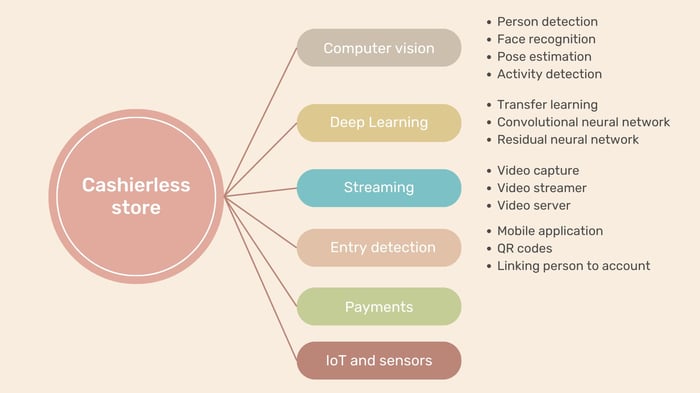
Features in cashierless stores. Source: LinkedIn
Benefits of automated and cashierless checkout for retailers
Enhanced Customer Experience: These systems significantly reduce waiting times, offering a smooth and streamlined shopping journey. This not only boosts customer satisfaction but also encourages repeat business.
Operational Efficiency: With automation, retailers can process a higher volume of transactions without the need for added manpower. This efficiency minimizes human error and standardizes the checkout process.
Cost Savings: In the long run, automation results in notable savings, particularly in areas like labor costs, training, and losses due to errors.
Improved Data Collection: Each transaction provides invaluable data about customer preferences and buying patterns. This data becomes instrumental for better inventory management, targeted marketing strategies, and personalized customer engagement.
Space Optimization: Eliminating the need for traditional checkout counters allows for better use of retail space, enabling retailers to either display more products or design more inviting store layouts.
Safety and Hygiene: In the backdrop of health concerns, reducing direct human interactions during the shopping process can also be seen as a health and safety measure.
Scalability: Regardless of the store's size, these systems can be scaled to meet changing demands, providing flexibility.
The future of intelligent, autonomous stores
As the tech evolves and retailers get more competitive, we’re likely to see:
- Hyper-Personalization: Stores will know your preferences, past purchases, and even moods. As you walk in, the environment might adjust, offering you products and deals aligned precisely with your needs at that moment.
- Experience Centers: With the rise of online shopping, physical stores might transform into experience centers. Here, the emphasis will be on the tactile and sensory experience, rather than just the transaction.
- Robotics Integration: Beyond just automation, robots might play a more active role. From restocking shelves to guiding customers, robotic assistants could become a common sight in stores.
- Decentralized Checkouts: Instead of a designated checkout area, customers might be able to complete their transactions anywhere within the store using mobile devices or even voice commands.
- Sustainability as Priority: Stores of the future will prioritize sustainability. From eco-friendly products to zero-waste policies, the shopping experience will be intertwined with green initiatives.
- Rent-Instead-of-Buy Models: As the sharing economy grows, we might see more stores offering rental models for products be it clothes, electronics, or even tools.
Some of these innovations will be powered by bleeding edge technologies such as:
- Augmented Reality (AR) & Virtual Reality (VR): AR and VR technologies are poised to take the shopping experience to a new dimension. Many retailers already offer options to digitally try on clothes, explore furniture in your living space before buying, or have a virtual assistant guide you through the store.
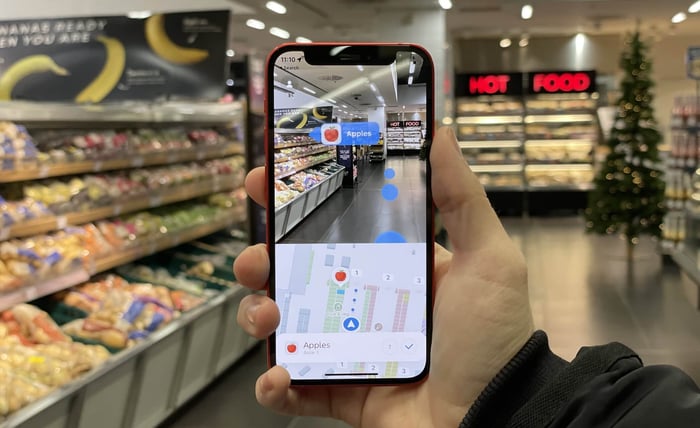
Source: TechCrunch
- Advanced Artificial Intelligence (AI): While AI is already a powerful disruptive force, future iterations will be more sophisticated. AI will predict shopping trends, automate inventory management with unparalleled precision, and offer hyper-personalized shopping experiences to consumers.
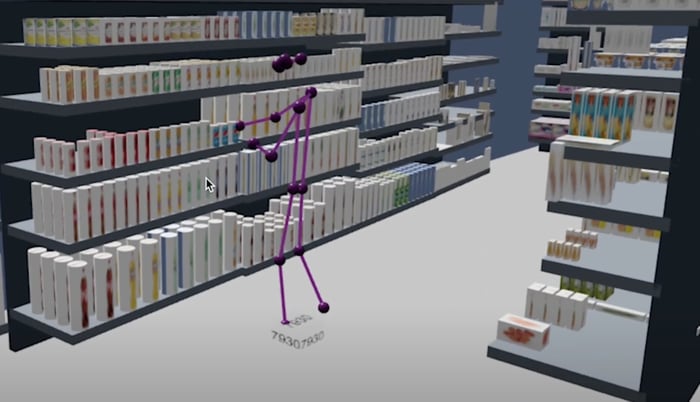
- IoT Evolution: The internet of things will become more integrated. Devices will communicate more efficiently, leading to smarter store environments that adapt in real-time to the needs of shoppers.
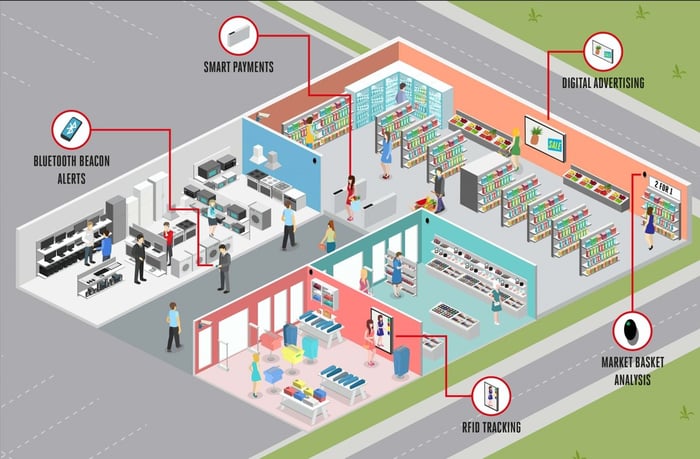
Source: Atalian Servest
- Biometric Verification: Beyond just facial recognition, we might see other biometric methods, like fingerprint or even heartbeat recognition, becoming integral to the shopping experience, ensuring security and personalization.
- Sustainable Technologies: As the global focus shifts towards sustainability, expect technological solutions that are eco-friendly, reduce waste, and promote sustainable shopping practices - like Żabka’s feature that combats food waste.
Behind the scenes - automated warehouses
One thing to keep in mind is that as the number of automated solutions in stores increases, the retailer should also consider transforming warehouses with robotics. Here are a couple of examples of how this can be done:
Example #1: Autonomous warehouse robots locating products
With e-commerce and the growing demand for faster deliveries, optimizing warehouse operations has become critical. To keep up with the pace, human workers need support from autonomous robots.
Amazon's Kiva Robots, now known as Amazon Robotics, have become synonymous with the future of warehouse automation. They have revolutionized Amazon's fulfillment centers, embodying the potential of robotics in streamlining logistical operations.
One of their main roles is to retrieve shelves and bring them to human pickers, eliminating the need for workers to walk around the warehouse. This drastically reduces the time necessary to process an order.
The robots navigate the warehouse floor using a series of QR codes, ensuring precision in their movements and tasks. Integrated with Amazon's inventory system, they always know the most efficient route to an item, ensuring optimal pathfinding and reduced delays.
Kiva robots can be reprogrammed quickly to adapt to changing inventory layouts or to accommodate the introduction of new products. This agility ensures that Amazon's fulfillment centers remain flexible and responsive.
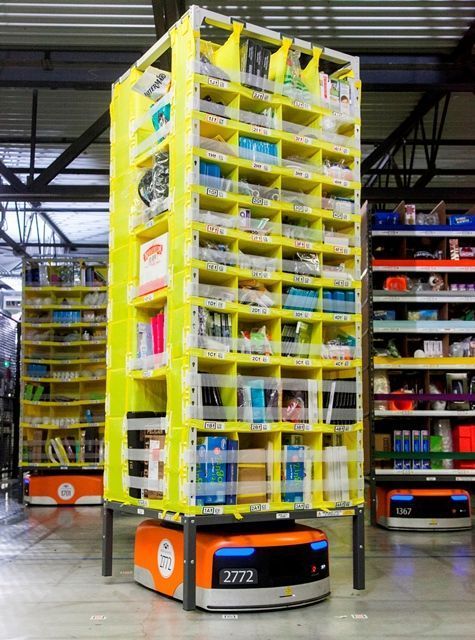
Source: YT
Example #2: Reinventing pallet discovery in modern warehouses
Focal Systems is renowned for its deep learning and computer vision solutions, specifically tailored for the retail sector. While their primary focus has been on optimizing the in-store experience, the underlying technology also carries significant implications for warehouse operations, particularly in pallet discovery.
Warehouses often rely on manual tracking systems or rudimentary electronic solutions that can't keep up with the pace and volume of modern commerce. This is where new tech comes into play.
By integrating advanced computer vision techniques, cameras placed strategically throughout the warehouse can quickly identify and locate specific pallets. No need for barcodes or RFID tags, so the process is quick and less prone to human error.
The deep learning algorithms employed by Focal Systems keep refining their accuracy. As more data flows in, the system gets better at identifying, categorizing, and locating pallets. This continuous improvement ensures that even as inventory changes or grows, the system remains efficient.
Real-time data feedback allows warehouse managers to optimize storage strategies, ensuring that frequently accessed items are easily reachable, and reducing the average retrieval time.
As the challenges of inventory management grow in complexity, solutions like this are becoming essential. Through advanced computer vision and deep learning, they're ensuring that the warehouses of today are prepared for the demands of tomorrow.
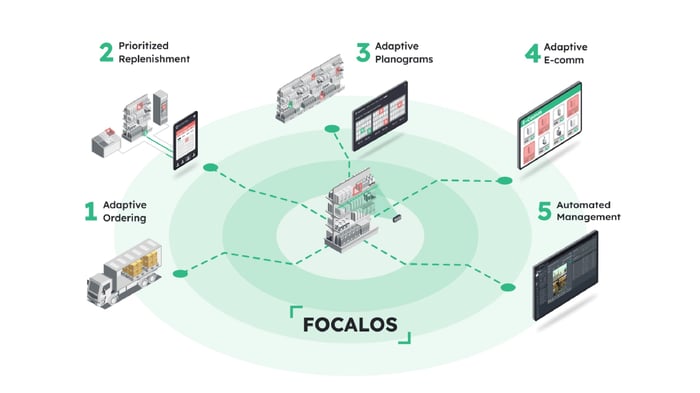
Self-driving store concept. Source: Focal Systems
Conclusion
Competition in retail has evolved, and now it’s not just about offering better products and prices, but about the whole buying experience.
Automated systems are empowering retailers to innovate, adapt, and thrive in an increasingly competitive market landscape.
Investing in automation encompasses a broad spectrum of operational, administrative, and financial benefits that can significantly enhance the profitability and efficiency of retailers in the long run.
What degree of automation would be viable for your stores? Let’s talk about it!



